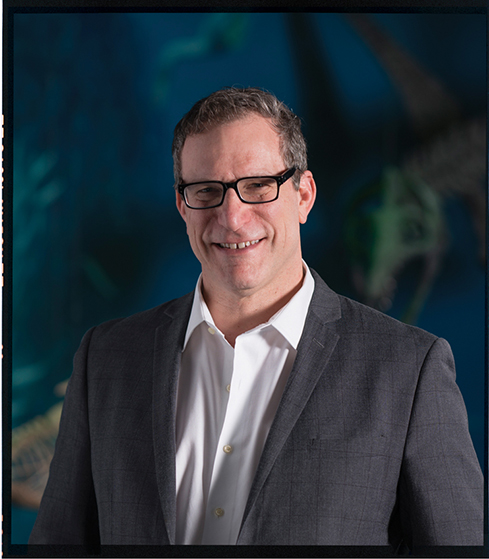 Summer 2016
Summer 2016|
Eric Dorfman
As a small child, Eric Dorfman pored over an animal encyclopedia that was bigger than he was. He never left the zoo without asking how soon he could return. And when French undersea explorer Jacques Cousteau or British naturalist David Attenborough were on television, he was glued to the set. As intense as his fascination was with the natural world, Dorfman was equally attracted to playing the piano and drawing. A part in a Shakespearean play when he was a teenager led him to discover not only that he liked theater, but that he was a terrific baritone. So much so that the California native considered a life as a professional opera singer. Then one day he faced a hard choice—attend a dress rehearsal or study for an important chemistry exam. Missing the rehearsal would mean losing his role. He chose science. It was a life-defining moment, he says, to realize he couldn’t do both, at least not full-time. With a master’s degree in marine science and a PhD in ecology, opportunities led Dorfman to museum work first at New Zealand’s national museum, Te Papa Tongerewa, and most recently as director of the country’s Whanganui Regional Museum and Ward Observatory, which quadrupled its annual visitation under his leadership. Now nine months into his role as director of Carnegie Museum of Natural History, Dorfman brings to Pittsburgh a soft New Zealand inflection to his voice; a contagious enthusiasm for every aspect of museum management; and a depth of experience in navigating the role of the 21st-century natural history museum that’s earned him international recognition as a speaker, collaborator, and writer. His excitement, too, is palpable about the possibilities inherent at Carnegie Museums for bringing together his passions—science and art—in refreshing and remarkable new ways. How do you see natural history and art intersecting?I’m a big fan of Da Vinci. For him, art and science were inseparable. It’s only since the Age of Enlightenment that we started to divide them and think of them as separate fields. One of the reasons that I was so excited about taking the job here is that there are two art museums in the Carnegie Museums family that I can draw inspiration from and synergize with, not only within their walls, but also by bringing them into the natural history museum. In fact, we’re working with the Museum of Art on an exhibition of cabinets of curiosities, which is going to be a lot of fun. Also, I think if you have a high level of drama and aesthetic value in your exhibitions, you can afford to let them be quite intellectually rigorous. People can engage with them at both levels. How will natural history museums stay relevant?I’m editing a book right now titled The Future of Natural History Museums that will be published by Routledge in 2017. There’s about 25 authors from all over the world, each thinking about where natural history museums are headed in the next 20 to 50 years. The future of natural history museums is huge because we are looking to interpret not just for the public but for planners and thinkers. We interpret the nature of the planet—past, present, and future. Our context is changing. Human intervention is disrupting the natural processes and cycles of the earth’s ecosystem. And a lot of the things that we took for granted as being study subjects are no longer there. Natural history museums are repositories of knowledge, and when the evidence around you is not there anymore—you turn to museums. And it’s not just about animals in collections; it’s the knowledge about their biogeography, about their interactions with each other. The potential problem-solving ability is a big part of it… that’s why we do research in museums. What ideas would you like to see the museum explore?With the concept of the Anthropocene, we’re discovering that a scientific topic can also have a major cultural component. To me, that is a very exciting trajectory. The Anthropocene is the idea that humans have had such a profound and pervasive impact on the planet that our presence on Earth will be detectable in the geographical layer that represents us millions of years in the future. When you think about all of the plastics, the chemicals, the changing CO2, the nuclear fallout—all these things will be embedded in the rocks that our descendants, or whoever is looking, will be able to detect as us. Should museums play an advocacy role in mitigating the impact of humans on the natural world?I’m president of the International Committee of Museums and Collections of Natural History. Last year, we came out with the Taipei Declaration, which essentially says that natural history museums should be involved in the direct conservation of nature. It doesn’t mean it has to be what we do completely, but it certainly needs to be a component of our work. Evolution is also very important. Understanding where we’ve been is also a fundamental part of what we do. So, yes, watch our space.
|
Ai Weiwei at The Warhol · Window into the Wild · Backyard Science · The Adventure Continues · Special Section: Tribute to Our Donors · President's Note · NewsWorthy · Artistic License: After Hours · Science & Nature: Teacher's Aide · Travel Log · The Big Picture
 |
Copyright © 2017 CARNEGIE Magazine. All rights reserved. |

